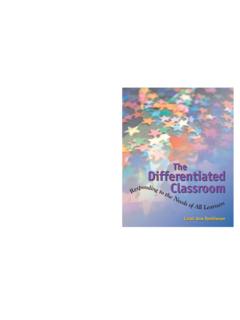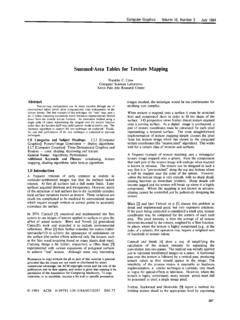Transcription of Structure and Properties of Matter
1 Structure and Properties of Matter 2nd grade Teacher s Guide Lesson 1 Length: 1 session: about 30 40 minutes Materials: What is the World Made Of? By: Kathleen Weidner Zoehfeld Sticky Notes White Board Overview: Launch unit with a subject introduction, student generated hypothesis, and an exploration walk. Engage: Sing States of Matter located in the teacher guide. Explore: Introduce Matter as a concept. Draw the idea chart from page 1 of the student journal on the board. Pass out sticky notes to each child and allow time for them to write ideas. Explain: Have students attach sticky notes to the board and have a classroom discussion based on their thinks, knows, wonders, and connections. Encourage the class to record other students responses in their journal.
2 Elaborate: Read What is the World Made Of? On page 1 of the student journal define in kid language solid, liquid, and gas. Evaluate: Go on a scavenger (indoors or outdoors) hunt for solids, liquids, and gases (student journal page 2). Come back for a quick whole group discussion. What did you find? (To the tune of Farner in the Dell) Solid, Liquid, GC1s Solid, Liquid, GC1s, Three st(1tes of mC1tter, Solid, Liquid, GC1s, A solid keeps its shC1pe, Some (1re hC1rd, some c(1n bre(1k, Like C1 tC1ble or C1 role of tC1pe, A solid keeps its shC1pe. A liquids shC1pe depends On the contC1iner thC1t's it's in. Like C1 cup, bottle, or metC11 tin, A liquids shC1pe depends A gC1s you c(1nnot see, It's in the (1irthC1t we breC1the, Helium, oxygen, or ste(1m, A gC1s you cC1nnot see.)))))))
3 1 Matter Reminds me I I Solid:_____ Liquid:_____ Gas:_____ I 2 Matter Scavenger Hunt Look for each of the following states of Matter : Solid LiquidGas Which state of Matter did you observe most often?_____ Which state of Matter did you observe least often?_____ Lesson 2 Length: 1 session: about 30 40 minutes Materials: At each group: Pipe cleaner Sticky bug Marble Porcupine ball Feather Sand paper Twizzler Cotton ball Rock Popsicle stick Hand Lenses (each student) Overview: Students and teacher will be creating anchor charts and observing Properties of various objects. We will be creating language which allows students to describe materials by their observable Properties . Engage: Let students know that we will be discovering the Properties of various objects.
4 Allow discussion for ideas about how to observe and what they can observe. This will lead into a natural transition for the next activity. Students will create anchor charts with texture, shape, and color words (student page 3). Discuss as whole group and hang chart in room. Explain flexibility and have students give examples of items that are flexible. Students will enter yes/no in the chart for flexibility. Explore: Have students open journals to page 4. Read the poem: Fingers Tell What can your fingers See for you? Whether a surface Feels old or new? Is it bumpy, lumpy, Slippery, slick? Prickly, scratchy? Hard as brick? Spongy, rough? Softer than dough? Touch it! See if your fingers know. Explain: Discuss and model how to use hand lenses.
5 Distribute materials to tables and allow students to explore Properties of materials. Observe and listen to students as they interact to encourage scientific language. Students record observations in the table on page 4. Evaluate: Ask open ended questions to foster higher order thinking. Questions include: What evidence do you How could you What Properties do these materials share? 3 Describing Properties Property:_____ Color Texture Shape 4 Describing Properties Color Flexible Can you bend it? Shape Texture How does it feel? Pipe Cleaner Sticky Bug Marble Porcupine ball Feather Sandpaper Twizzler Cotton Ball Rock (bumpy) Lesson 3 Length: 1 session: about 30 40 minutes Materials: Cotton Ball Marble Prior lesson materials optional Overview: Compare and contrast materials and their Properties .
6 Engage: Raise questions from the prior lesson: What did you notice? Where there Properties which two materials shared? Explore: Quickly review a Venn Diagram with your students. Create the first Venn Diagram on the board or overhead. Guide students in filling out diagram together. Encourage scientific language. Student page 5. Explain: Make an observation about the information. (The cotton ball and the marble have two Properties in common.) Elaborate: Have students complete the Venn Diagram on student journal page 6. Encourage them to pick two materials that have similar Properties as well as different. This may be a good time to pull students who are in need of extra support. ` Ask students to make an observation about the materials.
7 Evaluate: Come together for a quick whole group closing. Ask students to share out what materials they chose and observations they made. 5 Comparing and Contrasting Materials cotton ball marble Using the information in the Venn diagram, write an observation. Remember to use scientific language. _____ 6 Comparing and Contrasting Materials _____ _____ Using the information in the Venn diagram, write an observation. Remember to use scientific language. _____ Lesson 4 Length: 1 session: about 30 40 minutes Materials: Sponge Paper Towel Wax Paper Graduated Cylinder Medium Bowl with Water Funnel Overview: Students will find the material that is most absorbent.
8 We will create a graph and form a conclusion. Students will explore materials that contain Properties we use for an intended purpose: absorbency. Engage: Prior lessons have been based on Properties of materials. Draw on those lessons to make the connection that a material being absorbent is another property of a material. Explore: Let students know that we will be conducting an experiment to find an object that is the most absorbent. Brainstorm different household items that they know to be absorbent. Introduce the materials we will be testing: sponge, paper towel, wax paper. Complete the scientific process on student page 7. Do not fill out the conclusion until after the experiment. Fill a bowl with water.
9 Dip the first absorbent material in the bowl and squeeze its contents into a graduated cylinder. Graph results on student journal page 8. Repeat for the rest of the materials. Explain: Complete the conclusion on student page 7. Elaborate: Complete the definition for absorbent in kid language on student journal page 8. Evaluate: Quick whole group overview of the experiment. Which material would you choose to clean up a spill? What property does this material have that would persuade you to pick this material for a cleanup job? Extension: Take the growing alligator from the package. Ask students what Properties it has. Discuss what they believe will happen if we leave the alligator in distilled water all night.
10 Do the experiment and then discuss what Properties the alligator must have for it to be able to grow to such a large size. 7 I M M M M M M M M M M M M M M M M ICII=:I~I M M M M M M M M M M M M M M M M M IC. NOMe oate JllnCe [XP{tiMent R orDM ~ _,? . ~ PJ"ObleMtQUe~tiOI'l Ob~erVOtiOO~ 0 \1TP0th~~ 'ii Material~ ~ ~ .&> ~ procme ;;;;;;;, J~~~J&.::r' .. R~K ( w D 7/i'f; ~ COOCI~iOO ~f ~ = ~ I I I I ~~~~~ I I I I I I I ICII I I I ICI 8 How absorbent am I? paper towel wax paper sponge Absorbant:_____ ml of water 5 10 15 20 25 30 35 40 45 50 55 60 65 70 Lesson 5 (2 days optional) Length: 1 session: about 30 40 minutes Materials: Pipe Cleaners 3x5 Notecard Popsicle Sticks Washers Note: Arrange desks so that they are 4 inches apart in order to create a bridge across the two tables Overview: Students will be testing materials based on strength.)]}









